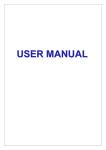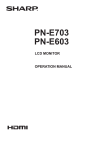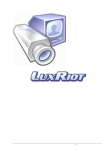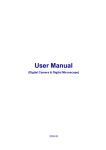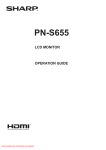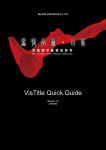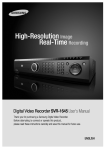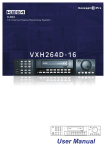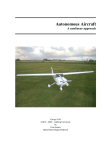Download USER MANUAL - Connectors Plus Inc
Transcript
USER MANUAL 1 IMPORTANT SAFETY INSTRUCTIONS Read these operating instructions carefully before using the unit. Follow all the safety instructions listed below. Keep these operating instructions handy for future reference. 1) Read these instructions. 2) Keep these instructions. 3) Heed all warnings. 4) Follow all instructions. 5) Do not use this apparatus near water. 6) Clean only with a dry cloth. 7) Do not block any ventilation openings, Install in accordance with the manufacturer’s instructions. 8) Do not install near any heat sources such as radiators, heat registers, stoves, or other apparatus (including amplifiers) that produce heat. 9) Do not defeat the safety purpose of the polarized or grounding- type plug. A polarized plug has two blades with one wider than the other. A grounding type plug has two blades and a third grounding prong. The wide blade or the third prong is provided for your safety. If the provided plug does not fit into your outlet, consult an electrician for replacement of the obsolete outlet. 10) Protect the power cord from being walked on or pinched particularly at plugs, convenience receptacles, and the point where they exit from the apparatus. 11) Only use attachments/accessories specified by the manufacturer. 12) Use only with the cart, stand, tripod, bracket, or table specified by the manufacturer, or sold with the apparatus. When a cart is used, use caution when moving the cart/apparatus combination to avoid injury from tip-over. 13) Unplug this apparatus during lightning storms or when unused for long periods of time. 14) Refer all servicing to qualified service personnel. Servicing is required when the apparatus has been damaged in any way, such as power-supply cord or plug is damaged, liquid has been spilled or objects have fallen into the apparatus, the apparatus has been exposed to rain or moisture, does not operate normally, or has been dropped. 2 OVERVIEW WARNING To reduce the risk of fire or electric shock, do not expose this appliance to rain or moisture. To prevent injury, this apparatus must be securely attached to the floor/wall in accordance with the installation instructions. 1) Be sure to use only the standard adapter that is specified in the specification sheet. Using any other adapter could cause fire, electrical shock, or damage to the product. 2) Incorrectly connecting the power supply or replacing battery may cause explosion, fire, electric shock, or damage to the product. 3) Do not connect multiple cameras to a single adapter. Exceeding the capacity may cause abnormal heat generation or fire. 4) Securely plug the power cord into the power receptacle. Insecure connection may cause fire. 5) When installing the camera, fasten it securely and firmly. The fall of camera may cause personal injury. 6) Do not place conductive objects (e.g. screwdrivers, coins, metal parts, etc.) or containers filled with water on top of the camera. Doing so may cause personal injury due to fire, electric shock, or falling objects. 7) Do not install the unit in humid, dusty, or sooty locations. Doing so may cause fire or electric shock. 8) If any unusual smells or smoke come from the unit, stop using the product. In such case, immediately disconnect the power source and contact the service center. Continued use in such a condition may cause fire or electric shock. 9) If this product fails to operate normally, contact the nearest service center. Never disassemble or modify this product in any way. (We are not liable for problems caused by unauthorized modifications or attempted repair.) 10) When cleaning, do not spray water directly onto parts of the product. Doing so may cause fire or electric shock. 11) Do not expose the product to the direct airflow from an air conditioner. Otherwise, it may cause moisture condensation inside the Clear Dome due to temperature difference between internal and external of the dome camera. 3 OVERVIEW If you install this product in a low-temp area such as inside a cold store, you must seal up the wiring pipe with silicon, so that the external air cannot flow inside the housing. Otherwise, external high, humid air may flow inside the housing, pooling moisture or vapor inside the product due to a difference between internal and external temperature CAUTION 1) Do not drop objects on the product or apply strong blows to it. Keep away from a location subject to excessive vibration or magnetic interference. 2) Do not install in a location subject to high temperature (over 50°C), low temperature (below -10°F), or high humidity. Doing so may cause fire or electric shock. 3) If you want to relocate the already installed product, be sure to turn off the power and then move or reinstall it. 4) Remove the power plug from the outlet when there is a lighting storm. Neglecting to do so may cause fire or damage to the product. 5) Keep out of direct sunlight and heat radiation sources. It may cause fire. 6) Install it in a place with good ventilation. 7) Avoid aiming the camera directly towards extremely bright objects such as sun, as this may damage the CCD image sensor. 8) Apparatus shall not be exposed to dripping or splashing and no objects filled with liquids, such as vases, shall be placed on the apparatus. 9) The Mains plug is used as a disconnect device and shall stay readily operable at any time. 10) When using the camera outdoors, moisture may occur inside the camera due to temperature difference between indoors and outdoors. For this reason, it is recommended to install the camera indoors. For outdoor use, use the camera with built-in fan and heater. 11) Risk of explosion if battery is replaced by an incorrect type. Dispose of used batteries according to the instructions. 12) LAN Ethernet cable should not be extended to outside of building. 4 BEFORE INSTALLATION ● Installation should be carried out only by qualified personnel and in accordance with any electrical regulations in force at the time. ● The DVR must be placed on a stable surface or mounted in an approved cabinet. Adequate ventilation must be provided, taking particular care not to block any of the air vents on the DVR. ● Adequate protection against lightning strikes and power surges must be installed to prevent damage to the DVR. ● Any safety warnings on the DVR and in these instructions must be adhered to. ● If cleaning is necessary, shutdown the DVR and disconnect power first. Use a soft dry cloth and only never use any abrasive cleaners. ● Do not attempt to service or repair the DVR as opening or removing covers may expose dangerous voltages or other hazards. Refer all servicing to qualified service personnel. 5 MAIN FEATURES MOUSE CONTROL Designed to be controlled and easy to use with a mouse. ENHANCED GRAPHICAL USER INTERFACE [GUI] The DVR menu structure and on screen display is presented in a simple to use and logical GUI format. GENUINE TRIPLEX OPERATION The DVR will continue to record at full frame rate during local playback, local setup, multi user remote viewing and playback and remote setup. AUDIO 16 audio inputs are supported which can be assigned to any video channel. Live and recorded audio can be monitored remotely over the internet and remote ‘talkback’ audio transmission to the DVR is also possible. BACKUP Recorded footage (including audio) can be archived to USB memory stick or CD/DVD. Playback software is embedded with the backup files and the backup also contains the system event log and backup log for full traceability. REMOTE CONNECTION Web connection is allowed up to 4 DVRs at the same time. Depending on the user level, full DVR control is available over the internet as well as the ability to remotely configure the DVR. Alarm outputs on the DVR can be remotely triggered over the internet. COMPREHENSIVE RECORDING SETUP Recording can be scheduled, alarm or motion activated. For each type of recording, frame rates, image quality and audio recording properties can be adjusted per hour, day and for each individual channel. The DVR also has a panic recording feature (from the front panel or external input) which overrides all other recording settings to provide the best quality recording in the event of an emergency. PTZ CONTROL Full PTZ control is available from the front panel or remote connection and a wide number of speed dome protocols are supported. Protocols can be set individually for each channel and PTZ speed can be adjusted to suit particular speed domes. 6 MAIN FEATURES TELEMETRY CONTROL Full telemetry control is available from the front panel or remote connection and a wide number of speed dome protocols are supported. Protocols can be set individually for each channel and telemetry speed can be adjusted to suit particular speed domes. EXTENSIVE MONITOR SUPPORT The DVR has 4 main monitor outputs (Composite, VGA, S-Video and HD MONITOR output). Four spot monitor outputs can be programmed in the DVR setup. LIVE DISPLAY The DVR displays single or multi screen images and also has several sequence modes (standard and user definable). CONFIGURATION BACKUP All configuration settings on the DVR can be saved to USB memory stick or a PC file remotely. The saved data can then be uploaded to other DVR units allowing rapid deployment where more than one DVR is being installed. EMAIL SUPPORT The DVR can send emails to specific users to notify events such as alarm, motion detection, video loss, hard drive failure, & etc. 7 SYSTEM ORGANIZATION Alarm Sensor Cameras Remote Client PC Alarm Output Image Printer Alarm I/O NETWORK AVI Backup TCP/IP Video In Web Client Archiving Video Out Remote Controller VCR HD Monitor USB Drive A/V Monitor 8 SYSTEM CONFIGURATION 1. Front panel description. KEY DESCRIPTION Function Key POWER Turn On/Off the system power DISPLAY Selects various display modes in live display and playback PTZ Selects PTZ mode in live display SETUP Displays the setup menus SEARCH Displays the search menu Control Key CHANNEL SELECTION Used to display individual channels in live display and playback BUTTONS Also used to enter numeric passwords for the various login screens CURSOR KEYS Allow to Navigate on the menu ENTER Apply or Select an item RETURN Cancel or go to Previous menu Playback Control JOG When playback is paused, used to move footage forwards or backwards, frame by frame HOLD Locks the current function of the SHUTTLE WHEEL so it can be released ◀◀ Increases reverse playback speed ◀ Selects reverse playback ΙΙ Pauses / resumes playback ▶ Selects forward playback and also accesses the instant playback feature ▶▶ Increases forward playback speed 9 SYSTEM CONFIGURATION 2. Rear panel description. A. CAMERA INPUTS and LOOP OUTPUTS: Connect up to 16 camera inputs. Loop outputs can be used for connection to other equipment. B. COMPOSITE AND S-VIDEO MAIN: MONITOR CONNECTIONS Both outputs can be used at the same time if more than one main monitor connection is required. C. SPOT MONITOR OUTPUTS: Up to 4 spot monitors can be connected as necessary. D. ALARM INPUTS: Up to 16 alarm inputs can be connected and configured as high or low Inputs with common ground. E. ALARM OUTPUTS: Up to 16 alarm outputs can be connected and configured as high or low outputs with common ground.. F. RELAY OUTPUTS: Up to 4 Relay outputs can be connected and configured as high or low outputs with common ground. G. RS485: Can connect PTZ camera and controller by two RS485 connectors. Left side : for PTZ. Right side : for keyboard controller.. H. E-SATA: Can connect ESTG by E-SATA cable. I. AUDIO INPUTS & OUTPUTS: Up to 4 audio inputs and one audio output can be connected as necessary. J. VIDEO SIGNAL SWITCH: Can change Video input signal type. Can select Video output. 10 SYSTEM CONFIGURATION Selectable Video outputs are HD, VGA, SD. Video output selection to choose only one. If user selects the video output to two or more duplicate, the video may not be output normally. If monitor spec doesn’t support DDC, the monitor can’t be recognized. 1) If you select HD output, 2) If you select VGA output, 3) If you select SD output, K. USB PORT: Can connect USB mouse or USB device for backup. L. HD MONITOR OUPUT: Can connect HD monitor output. M. VGA: Can connect VGA monitor output. N. RS232: Serial port. O. LAN: Can connect to a router or internal network. P. POWER: Can connect Power cable. 11 SYSTEM CONFIGURE – Remote Controller 3. Remote Controller description. POWER SETUP: Open System Setup Menu System ON/OFF Channel Selection Buttons ID Button AUDIO: Not Supported Select DVR ID ID ENTER: Apply / Select /Go to Next Screen RETURN Cancel / Deselect Navigation Buttons Previous Screen : Used for Playback Control, Menu Navigation, and PTZ/Focus Control DISP: Change display screen. SEARCH: Go to Search mode. PTZ: Go to PTZ menu. PANIC: Record by Panic setting. KEYLOCK: Lock the keys (Remote / Front) SEQUENCE: Change to Sequence screen. ZOOM: Go to Zoom mode. ARCHIVE: Go to backup menu. ※ If there are many DVRs on stack, each DVR must be set with different ID, the remote controller sets each ID per DVR, then all DVRs can be controlled with one remote controller by each ID. How to set ID on the remote controller : Press the ID button then displayed INPUT ID statement. Press the set ID and Press the RETURN button (The default ID is 01). For returning to the original situation, press the ID button again. And Input the 255 and press the RETURN button of remote controller. 12 CONNECT & POWER ON • Connect up to 16 CAMERA INPUTS as necessary. • Connect monitors to the DVR using the COMPOSITE, VGA, S-Video and HD MONITOR connections • Connect power to the DVR. The DVR checks for proper power connection and emits two beeps. Press the POWER BUTTON on the front panel of the DVR to begin operation. The DVR startup screen detects and checks the status of hard drives and the CD-RW / DVD-RW drive. After startup diagnostics are complete, the operator must logon to the system. The default user name is ‘ADMIN’. Using the CHANNEL SELECTION buttons, key in the default password of ‘1234’ and press the ENTER button. The DVR begins normal operation and shows the default display of all 16 channels. The status bar (Include menu control) at the bottom of the screen shows menu first time. After that, it will show the current time and date. A title for each channel is shown. The red square and letter ‘C’ in the top right of each channel display shows that the channel is recording in Continuous / Schedule mode. 13 MENU CONTROL All menus can be controlled from above ‘Status Bar’ with mouse or front buttons. LIVE DISPLAY DIVISION SCREEN Select the ‘DISPLAY” button and screen division menu will appear. Select the screen type (1, 4, 6, 8, 9, 16 and rotation sequence). Sequence mode User can select the type from display menu. Press the SEQ button. Each channel is shown in full screen for a set period of time before switching to the next channel. To stop the sequence on a particular channel, press the SEQ button again. More complex sequences can be programmed through the setup menu 14 LIVE DISPLAY PTZ 1) CAM: Select the Channel 2) Preset: If pressing the “GOTO” button after assigning the “Preset” in advance, sequence will be started. If double-clicking the Preset No. button, user can input the Preset No, by keyboard. 3) Avail. Position: User can see the available Preset location. If clicking the “GOTO” button after selecting it, camera will be moved. Press the “REMOVE” button to delete the saved Preset location. 4) Zoom, Focus, IRIS: User can control each item with + or - button. 5) Parameter Press this button and another window will appear. User can select each item from PTZ parameter menu. Digital Zoom Select the “ZOOM” button. When viewing a channel in full screen, the operator can zoom in to a particular area by up to 14 times. To use the digital zoom, select the required channel and press the ZOOM button. 15 LIVE DISPLAY User can see the current log immediately. Caution) When POS function is activated, user can’t use Live LOG function. Panic Recording This menu is used to start and stop the Panic recording. If the panic recording is started, record icon will change to red square with “P”. Select once more to return to previous. - Panic recording setup will be assigned from Record menu. 16 LIVE DISPLAY Quick Menu User can use quick menu by clicking the right of the mouse on each live channel. Click the right of the mouse on live channel that user wants to control. 1. Freeze On/Off: User can stop the live display of channel that user wants. Even though other channels show live display, this particular channel display is stopped. Click once more to return to previous. 2. PTZ Please refer to “PTZ” menu of Page 15. 3. Zoom Please refer to “ZOOM” menu of Page 15. 4. Panic Rec Start (Stop) Please refer to “Panic record” menu of Page 16. 17 SYSTEM SETUP Click the “MENU” and click the SYSTEM SETUP menu. To navigate around any items in the setup menu, use the CURSOR KEYS and the ENTER and RETURN buttons. In general, the ENTER button is used to select and change a particular item and the RETURN button is used to cancel a change or exit from a particular setup screen. To setup all main system functions, highlight SYSTEM SETUP and press ENTER. 18 SYSTEM SETUP CAMERA Click the CAMERA menu. CAMERA: CAMERA SETUP To setup the various camera options, highlight CAMERA and press ENTER. TITLE: Input the camera title. COVERT: When it is set to ON, the camera image is not displayed in live display but continues to record. AUDIO: Determines the audio recording channel. CAMERA: COLOR SETUP BRIGHTNESS, CONTRAST, TINT and COLOR can be adjusted for each individual channel. Highlight each channel to modify and press ENTER. 19 SYSTEM SETUP Click each value with button. The selected channel is displayed in full screen. BRIGHTNESS, CONTRAST, TINT and COLOR can be changed as necessary. To modify a different channel, highlight CAMERA and choose the desired channel. Press RETURN when all changes are complete. CAMERA : PTZ SETUP Click the PTZ SETUP menu and click each value on the ADDRESS, PROTOCOL and BAUD RATE menu. Change each value with button. ADDRESS: The unique ID of the PTZ device. PROTOCOL: The protocol of the PTZ device. BAUD RATE: The baud rate of the PTZ device. DETAIL: Detail setting for PTZ device. (Refer to the next page) TOUR: It is the PTZ TOUR function that it realized to S/W at DVR. It is independent of Tour supporting of PTZ Protocol. It is a monitoring function that PTZ Preset function is used with setting preset order and dwell time. 20 SYSTEM SETUP Click the “DETAIL” button and change the detail value with button. Note that some settings, such as AUTO FOCUS, may not be compatible with particular PTZ equipment. If this is the case, changing the value will have no effect on PTZ control. Click the “TOUR” button and set the MODE to [AUTO] to use TOUR function. First of all, please set PRESET number on the live PTZ mode. Then set the PRESET number 1 to 16 and DWELL Time. DWELL TIME means staying time on position until move next preset position. 21 SYSTEM SETUP CAMERA : MOTION SENSOR Click the MOTION SENSOR menu and click the value on the SENSITIVITY menu. Change the value with button. SENSITIVITY: Between 1 (Lowest) and 10 (Highest) and determines the degree of motion required before recording is activated. Click the button. AREA SETUP: Choosing this option allows the operator to define which areas of the image are monitored for motion detection. For quick select or deselect the entire grid, click the right mouse button and click the SELECT ALL or DESELECT ALL menu. - Red line area: Selected area - Yellow line area: Non selected area 22 SYSTEM SETUP DISPLAY To setup the various display options, highlight DISPLAY and press ENTER. DISPLAY - OSD Click the OSD menu. Then, click the button for ON/OFF and change the value. STATUS BAR: Determines the time to turn from the menu of status bar to time display. CAMERA TITLE: Determines whether the camera title is displayed. RECORDING MODE ICON: Determines whether the DVR recording status is shown at the top right of each channel display window. BORDER: Determines whether there is a border around each channel in multi screen display mode. BORDER COLOR: If the border is ON, the operator can choose the color. MOTION SENSOR DISPLAY: If false motion recording is occurring, the operator can use this feature to determine and rectify the cause in real-time. OFF – normal display mode. ON – areas where motion is detected are highlighted with colored blocks. MOTION COLOR: The color of the blocks displayed when MOTION SENSOR DISPLAY is set to ON. LANGUAGE: Determines the language type. 23 SYSTEM SETUP DISPLAY: MONITOR Click the MONITOR menu Then, click the button for ON/OFF and change the value SEQUENCE DWELL: The time of each screen is displayed in a sequence operation. SPOT DWELL: The time each screen is displayed on the spot monitor outputs. DE-INTERLACE MODE: When recording any channels in D1 resolution, this should be set to ON to prevent shudder during playback. ALARM POP-UP MODE: When set to ON, an alarm input will cause the associated channel to display in full screen. ALARM POP-UP DWELL: Determines how long the full screen popup is displayed after an alarm input. If the alarm condition continues, the popup screen is displayed constantly. MOTION POP-UP MODE: When set to ON, motion detection will cause the associated channel to display full screen. MOTION POP-UP DWELL: Determines how long the full screen popup is displayed after motion detection. If motion continues, the popup screen is displayed constantly. 24 SYSTEM SETUP DISPLAY: SEQUENCE Click the SEQUENCE menu. When the SEQ button is pressed, the default sequence will cycle through all 16 channels, one by one. Sequence setup allows the operator to define a custom sequence, using mixed multi screen views and any desired channels. Click the ADD menu. To add a new sequence, highlight ADD and press ENTER. Sequence title is highlighted – press ENTER to bring up the virtual keyboard and key in a name or reference number for the new sequence. Click on the ACTIVATION tab and click button for select ON/OFF. Select the SAVE. Then, below menu will appear. 25 SYSTEM SETUP Press ADD. Then, “Sequence Setup” menu appears. Determine the “VIEW TYPE” and assign “CONFIGURE”. Then, click CONFIRM. To add an additional mode, click ADD continuously. After finishing the setup, press CLOSE. To modify the current one, double click that mode. Then ‘Sequence Setup” window will appear again. The new sequence is now saved and can be started by pressing the SEQ button when in live view. 26 SYSTEM SETUP DISPLAY: SPOT-OUT Click the SPOT-OUT menu and click the camera channel for ON/OFF. The DVR has 4 SPOT MONITOR OUTPUT (Digital Spot). User can assign the SPOT OUT display for each channel. Double click the spot out channel that requires to be assigned. SPOT TITLE: input the title. ACTIVATION: Determines ON/OFF. Press MODIFY. (Below is default setup) To modify the current display, double click the display. Then ‘Spot Sequence Setup” window will appear. How to setup is same as Sequence setup. (User can assign 1 and 4 split display) To add the additional display, press ADD. 27 SYSTEM SETUP SOUND Click the SOUND menu. To setup the various sound options, highlight SOUND and press ENTER SOUND: AUDIO Click the AUDIO menu and click the ON/OFF menu. Then, click the button for ON/OFF. LIVE AUDIO: When it is set to ON, the selected audio channel can be monitored on the AUDIO OUTPUT. AUDIO MONITORING CHANNEL: Specify which one of the 4 AUDIO INPUTS is routed to the AUDIO OUTPUT. NETWORK AUDIO TX: When set to ON, live and playback audio is transmitted to a remote PC connection. NETWORK AUDIO RX: When set to ON, allows a remote PC connection to send audio back to the DVR. SOUND: BUZZER Click the BUZZER menu and click the ON/OFF menu. Then, click the button for ON/OFF. KEYPAD: When it is set to ON, each front panel button press is confirmed by a beep. 28 SYSTEM SETUP SYSTEM Click the SYSTEM menu. To setup the various system options, highlight SYSTEM and press ENTER. DATE / TIME Click the DATE / TIME menu. DATE TIME: Allows the operator to set or modify the current date & time. DATE FORMAT: Determines how the date is displayed. TIME FORMAT: Determines how the time is displayed. NETWORK TIME SERVER SETUP: If the DVR is connected to the Internet, the time and date can be accurately set by selecting SYNC and pressing ENTER. TIME ZONE SETUP: It should be set according to the region, which the DVR is used in. D.S.T.: When it is set to ON, the DVR will automatically adjust the time by one hour on the relevant date in spring and autumn. 29 SYSTEM SETUP SYSTEM: SYSTEM MANAGEMENT Click the SYSTEM MANAGEMENT menu. SYSTEM INFORMATION: User can see the system information as below. S/W version: Shows the firmware version of the DVR. H/W version: Shows the hardware version of the DVR. VIDEO SIGNAL TYPE: The DVR automatically switches between PAL and NTSC depending on the channel 1 input signal at power on. DISK CAPACITY: The first value shows the amount of hard drive capacity used by recorded footage, the second value shows the total hard drive capacity installed. IP ADDRESS: Shows either the manual IP address entered in NETWORK setup or the IP address assigned by a DHCP server if enabled. MAC ADDRESS: Shows the MAC (Media Access Control) address of the DVR. It is unique – no other network device has this MAC address. DDNS DOMAIN NAME: If DDNS is enabled, the host DDNS server is specified here. RTSP SERVICE PORT: The port number that the DVR uses to support remote connection from the client software. WEB SERVER PORT: The port number that the DVR uses to support remote connection from Internet Explorer or other web browsers. 30 SYSTEM SETUP SYSTEM NAME: It is used so that notification emails can be identified. F/W UPDATE: Firmware updates may be released periodically to enhance system performance and add extra features. The operator can upgrade the firmware using a USB memory stick. After inserting the F/W in USB or CD/DVD, press UPDATE. Then, below menu will appear. After selecting the F/W from F/W list, press UPGRADE. Then, F/W upgrade is started. FACTORY DEFAULT: If settings have been changed, which cause erratic behavior, the factory default settings can be loaded. SYSTEM DATA: System settings can be saved to a USB memory stick. The settings can be reloaded in case of accidental factory reset or can be transferred to another DVR if multiple units need to be installed with the same settings. All information is saved apart from network settings and system name. PASSWORD: Determines the PASSWORD ON/OFF to enter specific menu. SYSTEM: CONTROL DEVICE This will allow up to 254 DVRs to be controlled from the same keyboard. SYSTEM ID: If more than one DVR is connected on the same RS485 bus, each one must have a unique ID. Note: If using more than one DVR on stack, each DVR must have a unique ID for control by remote controller. PROTOCOL: Must be set by Control Device. BAUD RATE: Must be set to match the baud rate of the PTZ controller. 31 SYSTEM SETUP SYSTEM: POS SETUP POS ENABLE: This determine POS enable / disable. BAUDRATE: Must be set to match the baud rate of the POS device. PROTOCOL: Must be set by POS device.. ADDRESS: This determine POS device address of each channel. Caution) When POS function is activated, user can’t use Live LOG function and Control device.. 32 SYSTEM SETUP USER Click the USER menu. To setup the various system options, highlight USER and press ENTER. USER: USER MANAGEMENT By default, the DVR is configured with a user ID of ADMIN, belonging to the ADMIN group and with a password of 1234. As well as the ability to add new users, existing user details can be modified. To modify user details, highlight the user with the green cursor and press ENTER. The maximum number of users that can be created is 8. For editing, double click on the each tab. After changing, click OK. USER ID: Edit the user ID using the virtual keyboard. (Max. 10 characters) PASSWORD: Change the password using the virtual keyboard. (Max. 4 Characters) GROUP: Users can be assigned to one of three groups - ADMIN, MANAGER or USER. E-MAIL: Enter the user’s email address if email notification is required. (Max. 64 Characters) E-MAIL NOTIFICATION: Enable or disable email notifications for the specified user. 33 SYSTEM SETUP For ADD, double click on the each tap after clicking ADD. After changing, click OK. USER ID: Edit the user ID using the virtual keyboard. PASSWORD: Change the password using the virtual keyboard. GROUP: Users can be assigned to one of three groups - ADMIN, MANAGER or USER. E-MAIL: Enter the user’s email address if email notification is required. E-MAIL NOTIFICATION: Enable or disable email notifications for the specified user. USER: USER AUTHORITY User can give the authority to the MANAGER and USER. To select authority, click the APPLY button after selecting each item. Please note: Any user can be deleted except the default ADMIN user. USER: LOG OUT AUTO LOGOUT: Determines the AUTO LOGOUT ON/OFF. DURATION: In case of selecting AUTO LOGOUT ON, determines the duration. 34 SYSTEM SETUP NETWORK Click the NETWORK menu and determine each value. NETWORK: IP SETUP Click the IP SETUP menu. DHCP: When enabled, the DVR will obtain an IP address automatically if it is connected to a DHCP server or router. IP ADDRESS: If DHCP is not being used, the IP address can be manually set. GATEWAY: If DHCP is not being used, the gateway IP address can be manually set. SUBNET MASK: If DHCP is not being used, the subnet mask can be manually set. 1ST DNS SERVER: If DHCP is not being used, the first DNS server can be manually set. 2ND DNS SERVER: If DHCP is not being used, the second DNS server can be manually set. RTSP SERVICE PORT: If connected Router support UP&P (Universal plug and play) function, when you click the AUTO PORT, the port forwarding is automatically setup. And also can delete the port & test the port whether working or not. WEB SERVER PORT: If connected Router support UPNP (Universal plug and play) function, when you click the AUTO PORT, the port forwarding is automatically setup. And also can delete the port. The port number that the DVR uses to support remote connection from Internet Explorer or other web browsers. ALIAS: When you enter the DDNS HOST NAME in DDNS setup (Next page), you can see the information like below ex) 1234.dvrlink.net:8080 MAX TX SPEED: Specifies the maximum bandwidth that the DVR can use during a remote connection. 35 SYSTEM SETUP NETWORK: DDNS DDNS: When enabled, the DVR can be accessed through a Dynamic DNS server. Commonly used if a broadband connection does not have a static IP address. CAUTION To use DDNS function, User have to port forwarding. a. Default WEB SERVICE PORT : 8080 b. Default RTSP SERVICE PORT : 554 Default DDNS HOST NAME is Mac Address so user can connect by two different way. (Mac address / Own host name) a. 00115ff00213.dvrlink.net b. 1234.dvrlink.neet User can enter any DDNS Host name. NETWORK: E-MAIL Click the E-MAIL menu. SERVER: The SMTP outbound email server that should be used to send email notifications. PORT: The outbound email port number. SECURITY: Set to OFF if the SERVER does not require a username and password to connect. USER: Enter a username to identify the DVR in email messages. PASSWORD: If SECURITY is set to ON, enter the password here. FROM: Input the E-mail address or any text. It is only used for E-mail test (E-mail sender) TEST E-MAIL: User can test after inputting E-mail address to receiving test E-mail 36 SYSTEM SETUP EVENT / SENSOR Click the EVENT / SENSOR menu. To setup the various event handling options, highlight EVENT/SENSOR and press ENTER. EVENT / SENSOR: HDD EVENT Click the HDD EVENT menu. The DVR can monitor the hard drives and detect problems that may be developing. SMART ALARM: Enables SMART disk monitoring. CHECK INTERVAL: Can be adjusted as desired. DISK FULL EVENT: Determines ON/OFF. EVENT / SENSOR: ALARM INPUT Click the ALARM INPUT menu and click the OPERATION and TYPE value. Determine the behavior of each of the 4 alarm inputs. OPERATION: Alarm inputs can be enabled or disabled. TYPE: Alarm inputs can be set as normally open or closed. 37 SYSTEM SETUP EVENT / SENSOR: ALARM OUTPUT Click the ALARM OUTPUT menu and click each value. Determine the behavior and actions that will trigger each of the 16 alarm outputs. Behavior settings ALARM OUT: Choose which alarm output to configure. OPERATION: The selected alarm output can be enabled or disabled. MODE: Can be either TRANSPARENT (the output is active only when the trigger criteria is present) or LATCHED (the output is active for a set period of time after a trigger). DURATION: In LATCHED mode, the time that the alarm output remains active after it has been triggered. TYPE: Can be set to high (0V to +5V when activated) or low (+5V to 0V when activated). HDD EVENT: Determines whether a hard drive event triggers the alarm output. Action settings ALARM EVENT: Determines whether alarm inputs will trigger the alarm output. VIDEO LOSS: Determines whether video loss on any of the selected channels will trigger the alarm output. MOTION: Determines whether motion detection on any of the selected channels will trigger the alarm output. Remember to select APPLY and press ENTER to save all settings before exiting these menus 38 SYSTEM SETUP EVENT / SENSOR: BUZZER OUT Click the BUZZER OUTPUT menu and click each value. Determine the behavior and actions that will trigger the internal buzzer. Behavior settings OPERATION: The internal buzzer can be enabled or disabled. HDD EVENT: Determines whether a hard drive event sounds the buzzer. MODE: Can be either TRANSPARENT (the buzzer sounds only when the trigger criteria is present) or LATCHED (the buzzer sounds for a set period of time after the trigger). DURATION: In LATCHED mode, the time that the buzzer sounds after it has been triggered. Action settings ALARM EVENT: Determines whether alarm inputs will sound the buzzer. VIDEO LOSS: Determines whether video loss on any of the selected channels will sound the buzzer. MOTION: Determines whether motion detection on any of the selected channels will sound the buzzer. Remember to select APPLY and press ENTER to save all settings before exiting these menus 39 SYSTEM SETUP EVENT / SENSOR: EMAIL NOTIFICATION Click the EMAIL NOTIFICATION menu and click each value. Determine the behavior and actions that will send an email to a remote user. Behavior settings NOTIFICATION: Email notification can be turned ON or OFF. SETUP CHANGE: Determines whether a setup change sends an email. HDD EVENT: Determines whether a hard drive event sends an email. BOOTING EVENT: Determines whether a booting event sends an email. Action settings ALARM EVENT: Determines whether alarm inputs will send an email. VIDEO LOSS: Determines whether video loss on any of the selected channels will send an email. MOTION: Determines whether motion detection on any of the selected channels will send an email. FREQUENCY: E-mail sending period (Max. 60 MIN) Email settings must also be configured in MAIL and USER MANAGEMENT from USER MANAGEMENT menu. 40 SYSTEM SETUP DISK MANAGE Click the DISK MANAGEMENT menu. To manage the internal hard drives, highlight DISK MANAGE and press ENTER. RECORD TIME LIMIT: In certain circumstances, it may be necessary to limit the amount of footage stored on the DVR (to comply with data protection laws for example). Recording can be limited to 12 hours, 1 day, 2 days, 3 days, 4 days, 5 days, 6 days, 1 week, 2 weeks, 3 weeks, 1 month or 2 months. Once the DVR has this amount of footage stored, it will start to overwrite the earliest recorded footage. OVERWRITE: When set to ON, the DVR will start overwriting the earliest recorded footage, once the hard drive becomes full. In this case, the percentage of hard drive used shown in live display will always be 99%. When it is set to OFF, the DVR will stop recording when the disk becomes full. FORMAT: If necessary, all footage can be erased from the DVR using this option. Please note: When a RECORD TIME LIMIT is set, the OVERWRITE option cannot be changed 41 RECORD MENU RECORD MENU Click the “MENU”. Input the password. Then main menu will appear. Click the RECORD menu. To setup the recording behavior of the DVR, highlight RECORD MENU and press ENTER. RECORD : RECORDING OPERATIONS Click the RECORDING OPERATION menu and click each value. Then, click the value with button to change. SCHEDULE MODE: Either DAILY (one schedule will apply to every day of the week) or WEEKLY (each day of the week has its own schedule). PRE EVENT RECORDING TIME: When the DVR is not in continuous recording mode, this setting determines the amount of time that is always recorded before an event occurs. (motion detection, alarm input, etc). POST EVENT RECORDING TIME: When the DVR is not in continuous recording mode, this setting determines the amount of time that is always recorded after an event occurs. (motion detection, alarm input, etc). 42 RECORD MENU RECORD: CONTINUOUS/MOTION Click the CONTINUOUS/MOTION SETUP menu This setup screen allows the operator to configure scheduled and motion detection recording. There are 2 sections: SIZE/FPS/QUALITY: Recording settings for each channel can be defined across a 24 hour period, in blocks (for example between 09:00 and 18:00) or for each individual hour. Note that when SCHEDULE MODE is set to WEEKLY, each day of the week can also be selected. ACTIVATION: This section determines at what times the DVR will record and whether it is in continuous recording or motion detection. SIZE/FPS/QUALITY Click the SIZE/FPS/QUALITY menu. To change the SIZE/FPS/QUALITY, highlight CONTINUOUS/MOTION SETUP and press ENTER. Ensure the SIZE/FPS/QUALITY is highlighted in yellow and press ENTER again. The 24 hour time bar is highlighted in green. 43 RECORD MENU Click the TIME BAR that user wants to have the values changed. Press ENTER to display the green cursor. The green cursor shown represents one hour. The table below the time bar shows the recording settings for this time period. Drag the time that user wants to have the values changed. Example: To change the recording settings between 09:00 and 18:00. Use the CURSOR KEYS to move the green cursor to the 09:00 position and press ENTER. The cursor changes to orange to show the start position. Use the CURSOR KEYS to stretch the orange cursor across to the 18:00 position. 44 RECORD MENU Click the SIZE, FPS, QUALITY and AUDIO value. Then click the value with button to change. Press ENTER. Recording settings for the selected time period are displayed. Maximum recording frame rate is 480FPS at resolution of D1. SIZE: Recording resolutions of CIF, 2CIF or D1 can be selected for each channel. FPS: Frame rates between 1 and 30 can be set for each channel. QUALITY: Five different picture recording qualities can be set for each channel. AUDIO: If audio devices are connected to the DVR, user can select the audio recording on/off. Any audio channel can be assigned to any of the video channels. Please refer to camera setup menu. During playback, when a particular channel is selected in full screen, the assigned audio channel will be played back at the same time. Adjust values as desired and select OK to finish and return to the parameter menu. Other time periods can be configured in the same manner. Remember that if SCHEDULE MODE is set to WEEKLY, recording settings need to be changed for each day as well as for each particular time. Note: The DVR supports a maximum recording rate across all channels of 480frames per second at D1 resolution. As settings are adjusted, the ‘frames available’ at bottom left displays the number of available frames still remaining and must always be zero or higher. If, while changing recording settings, this figure becomes negative, recording resolutions and / or frame rates must be lowered to increase the ‘frames available’ value to zero or above. 45 RECORD MENU ACTIVATION Click the ACTIVATION menu. To change ACTIVATION settings, highlight CONTINUOUS/MOTION RECORDING and press ENTER. Use the CURSOR KEYS to highlight ACTIVATION and press ENTER. The schedule box is highlighted in green. Drag the Time and Channel with left mouse click. After selecting the area, determines the recording type. The schedule screen has 4 symbols to show the different recording modes. NO COLOR blocks: No scheduled or motion recording. SKY BLUE blocks: The DVR will record continuously. BLUE block: The DVR will only record while motion is detected. PURPLE block: The DVR will record continuously and with motion event. 46 RECORD MENU RECORD: ALARM SETUP Click the ALARM RECORDING menu. The setup is the same as CONTINUOUS/MOTION RECORDING This setup screen allows the operator to configure alarm input activated recording. SIZE/FPS/QUALITY: Recording settings for each channel can be defined across a 24 hour period, in blocks (for example between 09:00 and 18:00) or for each individual hour. Note that when SCHEDULE MODE is set to WEEKLY, each day of the week can also be selected. ACTIVATION: This section determines at what times the DVR will monitor the alarm inputs and activate recording. Please refer to Continuous / Motion setup on setting up SIZE/FPS/QUALITY and ACTIVATION. Alarm activated recording can be used in conjunction with Continuous / motion recording. For example, the DVR could be configured to record continuously at a low frame rate (set in Continuous / Motion Recording) and then increase to a higher frame rate during an alarm input (set in alarm setup). 47 RECORD MENU RECORD: PANIC SETUP Click the PANIC RECORDING menu. Select the Size, Frame, Quality and audio. During panic recording mode, the DVR will override all other recording settings and record continuously on all channels at the settings configured here. RECORD: NETWORK STREAMING SETUP Click the NETWORK STREAMING menu. Select the Size, Frame, Quality and audio. During Network Streaming mode, the DVR is possible to set remotely uploaded video, audio stream with using client program like Web RA. Maximum recording frame rate is 480FPS at resolution of CIF. 48 SEARCH SEARCH To search for a particular section of recorded footage, press the SEARCH button. To protect unauthorized viewing of footage, only ADMIN and MANAGER user levels can playback footage. To login as ADMIN, enter the default password of 1234 and press ENTER. SEARCH: TIME SEARCH Click the date that user wants to have the values changed. The DVR uses a calendar and timeline search method for quick access to recorded footage. The calendar displayed on the left shows the current month. Days highlighted in yellow have recorded footage. The timeline on the right shows a 24 hour status of all channels for the selected day. The recorded time will be displayed with different color on each recording type. Panic: White Motion: Green Timer: Sky blue Alarm: Red 49 SEARCH Drag the time bar with left mouse click. Press ENTER to select the calendar and use the CURSOR KEYS to move to the required day. As different days are selected, the timeline display also changes to show recorded footage on that day. Press ENTER to choose the day and move to the timeline. Click the PLAY (Multi View) buttons Use the CURSOR KEYS to move the timeline cursor left or right to select the time segment required. The currently selected time is displayed under the calendar. Press PLAY to begin playback from the selected time. 50 SEARCH SEARCH MODE: Multi Playback PLAY (Multi view): The default playback mode is 16 screen display. By pressing DISPLAY or using the CHANNEL SELECTION buttons, it is possible to display single screen or other multi screen formats in a similar way to the live display mode. When playback is paused, the <<, >> can be used to accurately move the footage forward or backwards, frame by frame. Playback speed and direction can also be controlled using the five playback buttons. 51 SEARCH During playback, user can reserve the recorded data that needs to be archived. Press button at the time the archive is to be started. Then playback is stopped and menu below will appear. After inputting “TAG” name, press START. Then display is returned to playback. Press button again to end archiving. Then menu below will appear again. RESERVE: Press this to reserve current data. CONTINUE: Press this to reserve more data. Then display will return to playback. STOP: Make sure to press this button to reserve current data first. Then user can select RESERVE. START: Press this to start the reserve. CLOSE: Finish archiving. Reserved data will be reserved on HDD. User can see the reserved data from “RESERVED DATA MANAGEMENT” on ARCHIVING menu 52 SEARCH To exit playback mode and return to the search screen to choose another time and date, press RETURN. To exit the search screen and go back to live view, repeatedly press RETURN. SEARCH : EVENT SEARCH The DVR event log stores events such as motion and alarm activated recording, video loss, etc. To search for an event and playback the recorded footage, press the SEARCH button and log in as ADMIN with the default password of 1234. Click the SEARCH BY EVENT menu and select each desired channel and condition. Then click the time with Click the SEARCH button. 53 button to change. SEARCH To playback footage for a particular event, select the event from the list using the CURSOR KEYS and press ENTER. Playback resumes from the moment when the selected event occurred and continues until stopped by the operator. During event search playback, the playback buttons can be used as normal. To stop playback and return to live view mode, repeatedly press RETURN. 54 SEARCH SEARCH : POS EVENT SEARCH The DVR POS event log stores events such as price, quantity, item keyword, date, etc. On SEARCH BY POS EVENT menu, it can search log price, quantity, item keyword, date, etc, and playback recorded video. Click the SEARCH BY POS EVENT menu and select each desired channel, condition and item keyword. Then click the time with Click the SEARCH button. 55 button to change. To playback footage for a particular event, select the event from the list using the CURSOR KEYS and press ENTER. Playback resumes from the moment when the selected event occurred and continues until stopped by the operator. During event search playback, the playback buttons can be used as normal. To stop playback and return to live view mode, repeatedly press RETURN. 56 ARCHIVING NEW ARCHIVING To archive recorded footage to USB memory stick or CD/DVD, press the ARCHIVE button. To protect unauthorized viewing and distribution of footage, only the ADMIN user level can archive footage. To login as ADMIN, enter the default password of 1234 and press ENTER. Click each desired channel. Then click the times with button to change. Click the QUERY menu. Make sure to press QUERY first before selecting BURN or RESERVE. Press “RELEASE” to reset after QUERY. RESERVE: Press this after inputting the TAG name. OR BURN: Press this after inputting the TAG name. Then press START after menu below appears. If pressing STOP during burning, it will be stopped. 57 ARCHIVING RESERVED DATA MANAGEMENT AVI ARCHIVING LIST: User can see the AVI archiving data that was reserved from new archiving menu or archiving of search. INFORMATION: The detailed information of Reserved AVI data. DELETE: User can delete the reserved AVI data BURN: Backup the selected AVI data. FTP SETUP FTP Archiving is possible if setting up the HOST Name, Port number, User Name, and Password having become setting to FTP server. FTP Archiving is possible on New Archiving or Reserved Data Management.. Archiving data is appeared in Directory of the name that they set up to 'DIRECTORY' if got from FTP backup. FTP TEST normally uses it to purposes to test Archiving possible to the FTP server which a user set up. 58 WEB CONNECTION SETUP PRELIMINARY BEFORE CONNECT For using web connection, 554 and 8080 ports should be done port forwarding set in Router. Refer the manual of Router for port forwarding setting WEB RA MINIMUM PC REQUIREMENT CPU P4 3.0 or Higher RAM 512MB or Higher Geforce MS 400, Radeon 7500 or higher VGA Gefore 8 series or higher VGA MEMORY 64MB MONITOR 1280X1024 BROWSER InternetExplorer, Firefox, Crome, Opera, Safari IE VERSION IE6.0 or higher NETWORK 100Mbps DIRECT X V7.0 or higher HOW TO CONNECT Input the IP Address or URL of the DVR in the Internet Explorer Address Bar. When user uses the DDNS service, input the URL as below. http://1234.dvrlink.net:8080 (webport :8080) or http://1234.dvrlink.net (webport :80) 59 Default ID and password are ‘ADMIN’ &’1234’ User need to install Active-X, click Run Add-on In case of, unable to install active-X, User needs to check the option of activeX on IE security menu. Select Enable for all ActiveX related options. (ex, Download signed ActiveX control, Download unsigned ActiveX control….) 60 WEB CONNECTION SETUP LIVE MODE Explanation for function LIVE mode Select live division screen (1, 4, 8,9,16 split mode) Sequence mode. Move to next camera Full screen. Select live channel. – select a channel manually. Activate Mic to send a sound to DVR. On/Off Sound from DVR Save the live image. Print the current screen. Snapshot the current screen. Setup [Render] and [Save Folder] 61 • Status: Show active status of DVR 1. Alarm – Indicator will be marked when system detects Alarm input. 2. Motion- Indicator will be marked when system detects Motion 3. Video Loss - Indicator will be marked when system detects Alarm input. 4. Recording – Display current recording mode (T: Continuous, M: Motion, A: Alarm recoding) 5. Alarm Out - Indicator will be marked when system detect Alarm output. 6. Refresh Time – set interval of refresh or Reload for manual refresh. • Log : Display all system logs with real time • PTZ : User allow to control connected PTZ camera. 1. Pattern – move a camera among several preset position 2. Preset – set a position of camera view. 3. Swing – move a camera between two preset point. * A WebRA Live screen can be done to Delay of two SEC between Local (DVR) and WEBRA. 62 SEARCH (by time line) 1. Select a time line on time table or set a exact time. 2. Then press ‘Play’ button 1. Refresh: Refresh the recording table of data. 2. Play: Start to display the recorded data from system. 3. Backup: User can backup the recorded data on remote site. 63 SEARCH (by event) 1. Event: Select events for querying. 2. Period: Set duration for querying recording data. 3. Search: Start to query and list up all events on the list Select a event on the list then DVR starting to playback the related camera’s image 64 SETUP MODE 1. CAMERMA user can configure camera’s attribute such as title, live color, PTZ setup or motion Motion setup for detecting motion events. 1) Select Motion menu tab. 2) Select a channel and sensitivity. 65 3) Drag a mouse on image for select detecting area. 4) Press OK. 2. Display 1) OSD – User allow to choose text display items over the image. 2) Monitor - user can set dwell time for sequence or spot, and pop up function. 3. Sound 1) Audio Setting – Select a live audio channel and activation 2) Buzzer setting – Activate buzzer out for evnet notification 66 4. System User can configurable DATE of system, check system information and set controller. 5. Recording User can configure the recording parameter, Setting detail is same as system. 67 6. User Allow to add user, select Authority level and Log out time 7. Network User can check the system’s network information and selectable speed level. But IP settings are not allowed to change on remote site. Network IP only can set on system. For email notification, user can input the SMTP server detail on below setup. 68 8. Sensor Management can set all device option of Alarm in/out, Buzzer out for event notification. (HDD EVENT, Alarm Input, Alarm output, Buzzer Out, E-mail notification option) All detail setup follow DVR system setup INFORMATION Display Model name of DVR and WEB Remote Software version. 69 WATERARK PROCESS 1. Open the backup data from device and Run the [bplayer] which is included in the backup folder. 2. Click the [Open file] button and open the backup file. 70 3. After open it, can see the following message then click the [Yes] button. 4. If the backuped AVI file is modified, [Verification failed] message will be appeared. 71 SMARTPHONE CONNECTION ♣ I-PHONE 1. Select the Safari browser. 2. Enter the IP address or URL to connect. And Click the [GO] button. 3. Enter the User name and Password then use can see the Image. (Default ADMIN / 1234) 72 ♣ BlackBerry 1. Select the Web browser. 2. Enter the IP address or URL to connect. And press the Enter button. 3. Enter the User name and Password then use can see the Image. (Default ADMIN / 1234) 73












































































